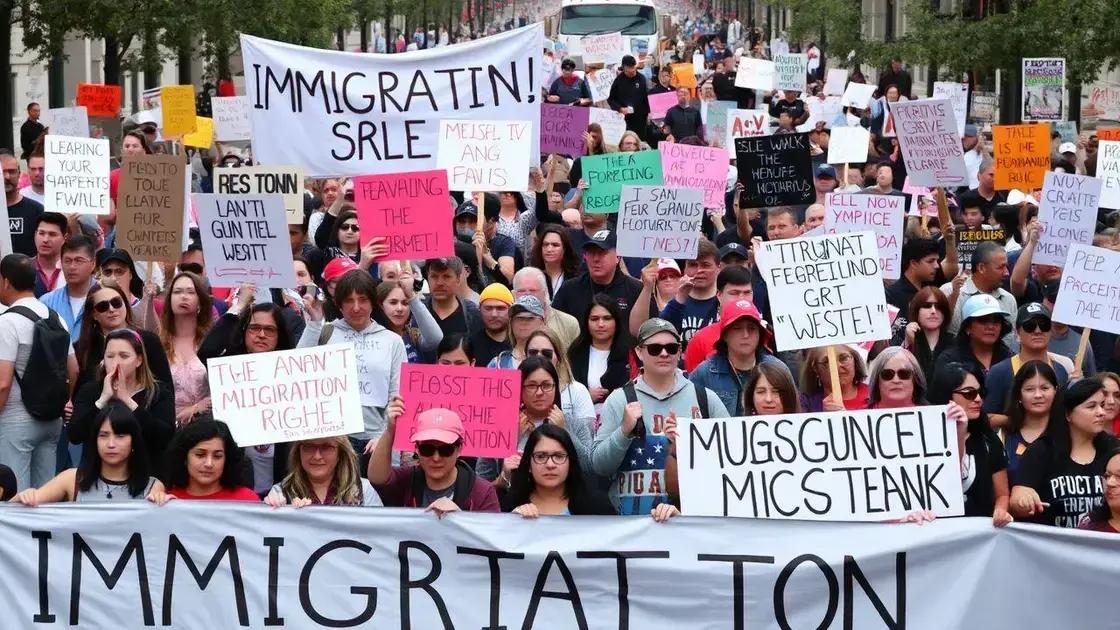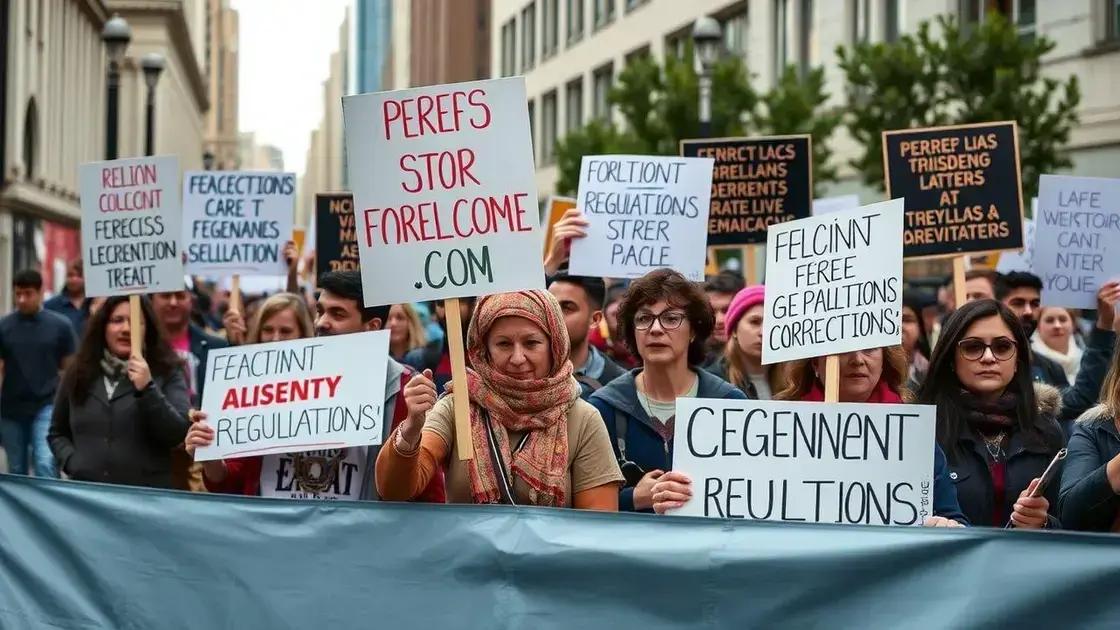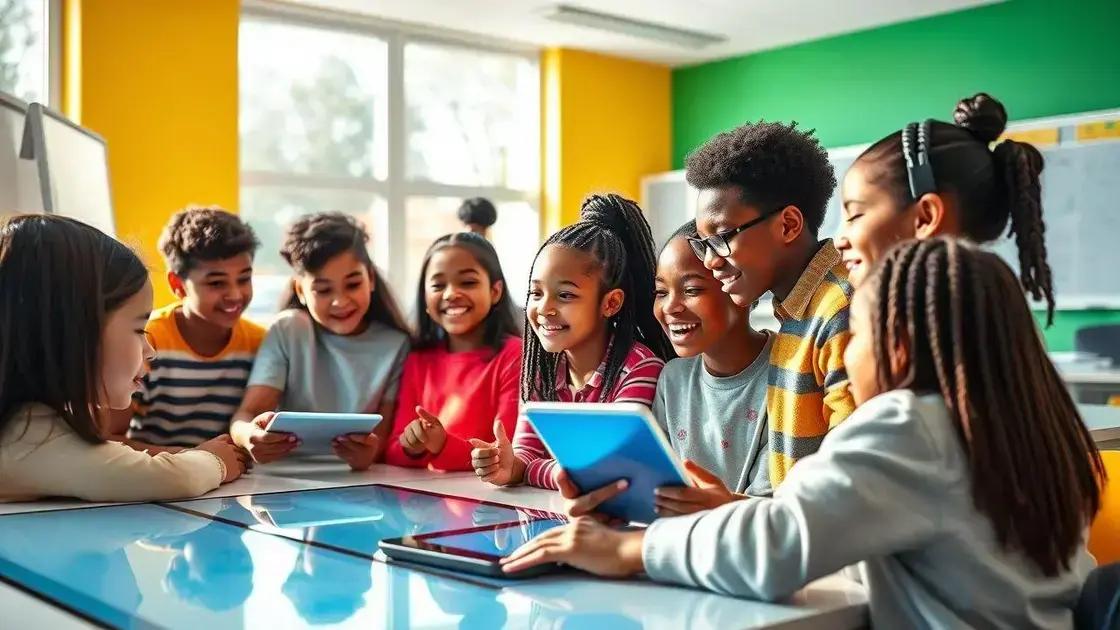Immigration rights demonstrations escalate in April 2025

Immigration rights demonstrations escalate in April 2025, highlighting the urgent need for justice and reform, driven by powerful personal stories and community activism against restrictive policies.
In April 2025, immigration rights demonstrations escalate across the nation, highlighting critical issues and community sentiments. What drives these protests? Let’s dive in and explore the voices and stories emerging from this significant movement.
The significance of immigration rights
The significance of immigration rights cannot be overstated. These rights are essential for ensuring that individuals can live, work, and thrive in a country irrespective of their nationality. As we explore this topic, it’s clear that understanding the meaning and impact of immigration rights is crucial.
What Are Immigration Rights?
Immigration rights refer to the legal protections and entitlements that individuals have while residing in a country where they are not citizens. These rights enable immigrants to pursue opportunities without fear of discrimination or deportation. They are fundamental to preserving human dignity and promoting equality.
- Access to legal representation.
- Protection from unlawful detention.
- Right to work and earn a living.
- Ability to seek asylum or refuge.
These rights are often challenged, leading to widespread demonstrations and a call for reforms. In many regions, immigrants face barriers that can impede their ability to live safely and freely. Different factors influence the protection of these rights, including political climate, societal attitudes, and legal frameworks.
The Role of Community Activism
Community activism is vital in advocating for immigration rights. Grassroots movements often unite diverse groups, emphasizing solidarity and shared goals. Through protests, campaigns, and educational initiatives, these activists work to raise awareness about the injustices faced by immigrants.
Moreover, community leaders play an essential role in navigating the legal landscape, offering resources to help individuals understand their rights. This support creates pathways for immigrants to contribute meaningfully to society while feeling secure in their status.
As the dialogue around immigration continues to evolve, recognizing the significance of immigration rights becomes even more crucial for fostering inclusive societies. It all starts with awareness and the collective efforts of communities.
Key events and protests in April 2025
April 2025 was a significant month for immigration rights as various key events and protests emerged across the nation. These events highlighted the ongoing struggle for justice and equality within immigrant communities.
Major Protests
Several large-scale protests took place, drawing thousands of participants who called for reform and justice. Each protest had its own unique focus, but all shared a common goal of advocating for immigration rights.
- Demonstration in Washington, D.C.
- Los Angeles rally for immigrant families.
- New York City march demanding policy changes.
- Community gatherings in smaller towns.
The protests were marked by powerful speeches, passionate chants, and signs that conveyed messages of hope and urgency. Activists emphasized the need for comprehensive immigration reform to protect vulnerable populations. Many speakers shared personal stories that illustrated the challenges faced by immigrants, making the cause relatable and urgent.
Impact on Local Communities
The impact of these events was felt strongly in local communities. Many people came together to support the protests, demonstrating solidarity with those affected by immigration policies. Local organizations mobilized to provide resources such as food, transportation, and legal aid to participants.
As news spread, more individuals became aware of the importance of immigration rights. Conversations about diversity, inclusion, and policy reform started to gain traction in the public sphere. This raised awareness helped to show that the fight for immigration rights isn’t just a political issue—it is a humanitarian one.
As April progressed, the momentum from these events fueled further discussions about how to ensure that everyone, regardless of their immigration status, can live with dignity and respect.
Voices from the frontline: Personal stories

Voices from the frontline reveal the powerful personal stories of individuals impacted by immigration rights. Each story highlights the hope, struggles, and resilience within immigrant communities. These narratives provide a human perspective to the ongoing fight for justice.
Personal Testimonies
Many immigrants have faced immense challenges as they navigate the complexities of their status. One common theme in these stories is the pursuit of a better life. For some, leaving their home country meant leaving behind family and familiarity, but it was often necessary for survival.
- Maria left her home in search of safety and opportunity.
- Juan documented his journey as an undocumented worker.
- Amina spoke about her struggles as a refugee seeking asylum.
- David shared his experience of living in fear of deportation.
Through sharing their experiences, these individuals bolster the movement for immigration rights. Each voice adds depth to the understanding of these issues, showcasing the courage of those who fight for their rights every day. The emotional weight of their stories resonates within communities, inspiring others to join the cause.
Building Community Through Storytelling
Storytelling plays a vital role in building community among those affected by immigration issues. When people hear each other’s stories, it fosters empathy and understanding. Events that allow individuals to share their experiences help create a supportive network for immigrants.
Additionally, these personal stories often lead to broader discussions about policy change and the need for fair treatment of all individuals, regardless of their immigration status. By amplifying these voices, advocates can effectively challenge stereotypes and promote a more inclusive society.
Government responses to rising demonstrations
As the demonstrations for immigration rights intensified, government responses varied significantly across different regions. These reactions often revealed deep divisions in policy and public opinion regarding immigration.
Official Statements
Many government officials issued statements addressing the concerns raised by protesters. Some leaders expressed support for immigration rights, emphasizing the importance of inclusivity and humane treatment for all individuals. Others, however, took a more defensive approach, emphasizing the need for border security and legal compliance.
- Supportive statements that acknowledge immigrant contributions.
- Defensive rhetoric focusing on law and order.
- Calls for dialogue between communities and government.
- Statements advocating economic benefits of legal immigration.
These statements significantly influence public perception and can either galvanize support for reforms or incite further unrest. The tone of these communications impacts community relationships and the overall dialogue surrounding immigration.
Policy Changes and Proposals
In response to the pressure from public demonstrations, some governments began to propose changes to existing immigration policies. These proposals often aimed to address the demands for clearer pathways to citizenship and protections for vulnerable immigrant populations. However, the pace of change varied widely.
Some areas introduced legislation aimed at providing protections, while others saw increased enforcement measures. The tension between humanitarian considerations and security concerns highlights the complexity of the immigration debate.
Grassroots organizations often work in conjunction with lawmakers to advocate for sensible reforms. By presenting research and testimonies, activists push for policies that reflect the necessities of immigration rights. This ongoing dialogue is crucial to the future of immigration policy and the welfare of communities affected.
Future of immigration rights advocacy
The future of immigration rights advocacy is filled with both challenges and opportunities. As public awareness grows, advocates are finding new ways to promote justice and equality for immigrant communities.
Emerging Strategies
Advocates are increasingly using technology to mobilize supporters and spread awareness. Social media campaigns have become vital tools for reaching broader audiences. By sharing stories, statistics, and calls to action online, organizations can engage younger generations and keep issues at the forefront.
- Utilizing social media for awareness and mobilization.
- Creating online petitions to influence policy.
- Collaborating with influencers to amplify voices.
- Hosting virtual events to educate supporters.
These strategies are not only effective; they also allow for a more inclusive conversation where diverse voices can be heard. As technology evolves, so too will the methods for advocacy, opening new doors for engagement.
Coalitions and Alliances
The future of immigration rights advocacy will likely see increased collaborations among organizations. By forming coalitions, groups can pool resources, share expertise, and enhance their impact. Such alliances can strengthen the fight for immigrant rights by creating a unified front.
Working together, different organizations can address various aspects of immigration issues, from legal assistance to housing support. These coalitions foster a sense of community and belonging, making it clear that the fight for immigration rights transcends borders and focuses on fundamental human dignity.
As advocacy evolves, it will be critical to maintain an inclusive dialogue that resonates with a broad audience. Engaging local communities and listening to their needs will help shape the future roadmap for immigration rights advocacy, ensuring that it remains relevant and effective.
FAQ – Frequently Asked Questions about Immigration Rights Advocacy
What are the main goals of immigration rights advocacy?
The main goals include ensuring humane treatment, providing a pathway to citizenship, and protecting the legal rights of all immigrants.
How can technology assist in immigration rights advocacy?
Technology allows for greater outreach through social media campaigns, online petitions, and virtual events, enabling advocates to engage with a wider audience.
Why is community storytelling important in advocacy?
Community storytelling humanizes the issues faced by immigrants and fosters empathy, making the advocacy efforts more relatable and impactful.
What role do coalitions play in the fight for immigration rights?
Coalitions strengthen the advocacy efforts by pooling resources, sharing knowledge, and presenting a united front to influence policy changes.






